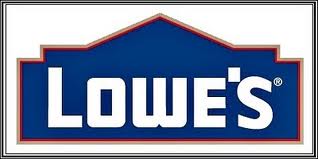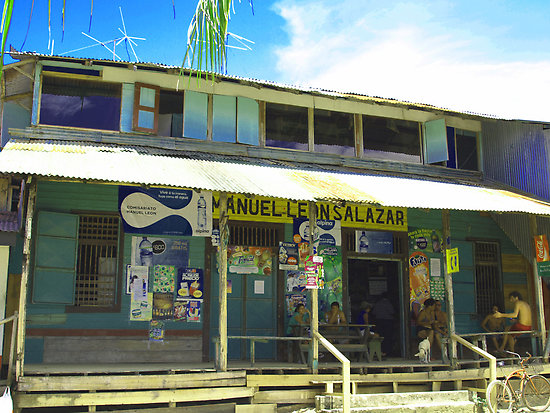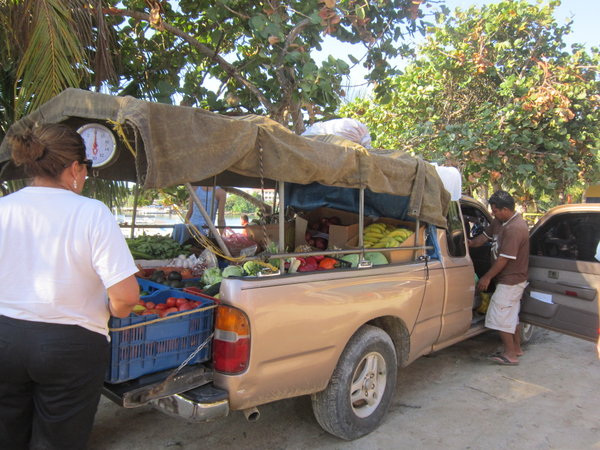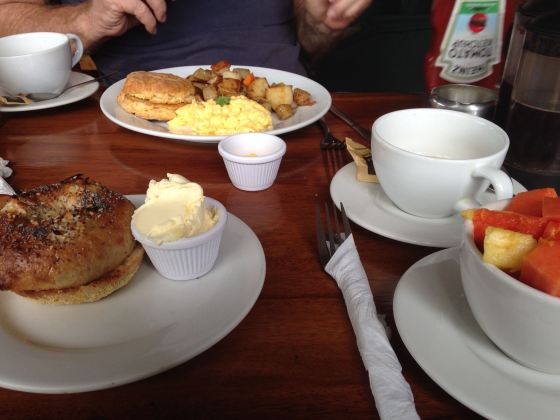 “I see we finally got a Lowe’s.”
“I see we finally got a Lowe’s.”
This would be A. speaking to me a couple of years ago as we bounced along in our pickup over the moonscape road between our house and Puerto Viejo. He says things like this to me all the time. I’ll be daydreaming and suddenly I become aware of something he said that is completely out of context.
“What do you mean there’s a Lowe’s here?”
“Right over there by the pulpería. See it?”
Sure enough, across the road at the little grocery store where I do most of my shopping, I saw the delivery truck with LOWE’S written boldly across its side in stocky white letters on a blue background in the shape of a house. It even said: “Let’s build something together” right underneath, as well as the 800- number.
“Well, that will be nice,” I said. “I wonder when Home Depot will be here?”
We both laughed, knowing full well that neither Lowe’s nor Home Depot would be here in the foreseeable future.
As we drove by, one of the workers handed another a crate of vegetables from the back of the second-hand Lowe’s truck. He, in turn, slung it up onto his shoulder and headed into the store. I could see bright green celery and bronze leaf lettuce mounded over the edge of the crate.
“We have to stop there on our way home. That produce looks pretty good.” I said.
It hadn’t always been this easy to find food on this Caribbean coastline.
When we first moved to Punta Uva in the early ’90s, my Stateside son asked: What kind of place is it, anyway?
It’s the sort of place, I said, that when you want a chicken sandwich, you bake bread, you cook a chicken, then you make mayonnaise… and then, you make a chicken sandwich. There will be no lettuce on it.
There were a couple of options available to me back then. I could go to the Chino’s in Puerto Viejo or I could shop off the trucks.
The Chino’s was an old-style commissary run by Manuel Leon, a local businessman of Chinese descent. His place dated back to the days of United Fruit, when they owned most of the land and employed most of the people. The workers spent their hard-earned money at the commissary and chances are they never got ahead.
Leon had the only grocery in town, and, according to A., everyone who couldn’t get to Limón was pretty much subjected to whatever Leon felt the market would bear. He also owned the only telephone line in the town.
 The place still sits right on the beach, the surf breaking idly out front, palm trees swaying in the breeze. But the first time I saw the place was in the fall of 1994.
The place still sits right on the beach, the surf breaking idly out front, palm trees swaying in the breeze. But the first time I saw the place was in the fall of 1994.
Climbing a set of very high and steep steps, we entered a big rectangular room painted institutional lima green. The room had a counter around three sides. Spongy wooden floorboards covered with sand bagged under our footsteps. Surfer types waited idly on the front porch for the phone. Behind the counter were twelve-foot high shelves. 
There were cooking pots and pans, pressure cookers, plastic food containers, electric rice cookers, as well as some unrecognizable forms covered with dust on the upper shelves. Canned goods were on the midlevel shelves. Some of the labels were so old and sun bleached it was apparent I would have to take the Chino’s word for what was inside. Further down there were a couple of bins with some dismal looking vegetables: rubbery carrots with black spots, fruit fly covered onions, a couple of heads of cabbage and some potatoes with visible holes weeping snot-like slime. Liquor, cigarettes, and medicines… he kept those items right behind where he stood guard over his establishment.
There was no way to get to any of the items. It became clear to me that I would have to ask for what I wanted and I had no Spanish to make myself understood. Pointing seemed to be the way, and I was sure he would give me the oldest stuff first.
I was just about to do it, too, when A. said, “Don’t buy any vegetables. We can get those off the trucks. Just buy the dried stuff you need.”
I pointed at a bag of black beans, some rice, and a few other staples and Manuel policed them until we paid. He calculated the bill using an abacus and for me, because I was a Gringa, double-checked it with a calculator.
I never bought from him unless I had no choice and I haven’t been in there in years, but he is still there and last I heard he has the same attitude, charging people the credit card commission when they use one. He’s a cash-only kind a guy.
I bought vegetables from the trucks for years and, compared to the Chino’s produce, it was luxurious. Once a week the “verduras” or vegetable trucks would come down from the Central Valley. Now they look like this one, but before you had to recognize them by the exterior paneling. And they were big. 
There were two that ran the route for years. One had the logo “Ivan Smith Furniture” on the side, presumably from its former job somewhere in the USA, and the other a big truck with a green tarpaulin high up over the back.
We spent a lot of our life waiting for them. We knew what day they came, but what time was another matter. If we were out and about with the car and happened to see them on the road, we stopped and bought right there. Other times people passing by would tell us where they had last seen it, so we had an idea of the wait time.
The first Spanish words I learned were vegetable names.
The drivers were patient and showed me what they had, repeating the names for me. As a matter of survival I learned quickly. The produce they pulled out of the boxes bore no resemblance to the sad specimens at the Chino’s. Boxes overflowed with enormous crisp and juicy carrots, wonderful avocados that I had never seen before. They were smooth-skinned, a wonderful pale shade of green, the meat rich and buttery. Cabbage and beets, “repollo” and “ramalachas”, which I always mixed up. Sometimes I’d end up with one when I wanted the other. Lettuce was not to be found until many years later.
Now there are fresh vegetables of all sorts. They come in three times a week to multiple pulperías, and organic vendors come to the Saturday market every weekend. We have bakeries with fresh bread, a Israeli who makes a mean pita, and because there are so many foreigners living along this coast the markets now carry items like miso paste, tahini, and lots of vegetarian options. I’ve seen an entire rack of soy, rice and almond milk in various flavors. We have imported cheeses, artisan cheeses, and fresh milk. A couple of Spaniards sell hand-crafted sausage and salami at the farmer’s market every Saturday.
What was once a little bare-bones, dirt-street Caribbean town is now a foodie’s delight. Here is a photo of the breakfast we had this morning at the sublime Restaurante Bread and Chocolate.
My, how things change.

